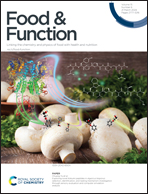Water solubility differentiates the impact of tea polyphenols and rutin on the postprandial glycemic response to cooked maize starch
Abstract
Postprandial hyperglycemia is an independent risk factor for cardiovascular diseases, and the impact of tea polyphenols (TP) and rutin, representative phenolic compounds with different water solubilities, on the postprandial glycemic response to cooked normal corn starch (CCS) was investigated. Comparatively, TP (DPPH50 = 0.12 mmol L−1) are more potent than rutin (DPPH50 = 0.50 mmol L−1) in scavenging the free radicals of DPPH, but both TP and rutin inhibited the activity of porcine pancreatic α-amylase (PPA), the major enzyme in starch digestion, with an IC50 of 4.09 mmol L−1 and 2.71 mmol L−1, respectively. However, an in vivo study showed that a significant reduction in postprandial blood glucose was only observed in the presence of rutin, and TP had no effect on the glycemic response to CCS. To find out the underlying mechanism, fluorescence spectroscopy and molecular docking were carried out and they showed that, compared to TP, rutin bound to the active site of PPA with higher affinity and a lower free energy (ΔG) driven by hydrogen bonds and π-stacking, and rutin also greatly increased the viscosity of starch. Collectively, water-soluble TP have a higher antioxidant property and a lower potency to inhibit PPA compared to water-insoluble rutin, and the weaker interaction between TP and PPA, and starch as well might synergistically contribute to TP's ineffectiveness in lowering the postprandial glycemic response, and water solubility linking the molecular structures and functions of phenolic compounds might be the fundamental basis for the observed difference in their biological functions, and water solubility can also be used to enrich specific phenolic compounds for desired functions.



 Please wait while we load your content...
Please wait while we load your content...